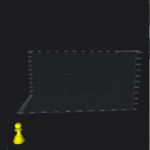I created an ObjectModel3D object in ViewModel and bound it to View, but the Scale and Position values are not applicable.
What’s wrong with my code?
View:
<UserControl x:Class="Example.TestChart.Views.TestChartView"
xmlns="http://schemas.microsoft.com/winfx/2006/xaml/presentation"
xmlns:x="http://schemas.microsoft.com/winfx/2006/xaml"
xmlns:mc="http://schemas.openxmlformats.org/markup-compatibility/2006"
xmlns:d="http://schemas.microsoft.com/expression/blend/2008"
xmlns:local="clr-namespace:Example.TestChart.Views"
xmlns:locals="clr-namespace:Example.TestChart.ViewModels"
xmlns:s3D="http://schemas.abtsoftware.co.uk/scichart3D"
mc:Ignorable="d"
xmlns:prism="http://prismlibrary.com/"
prism:ViewModelLocator.AutoWireViewModel="True"
xmlns:object="clr-namespace:SciChart.Charting3D.Visuals.Object;assembly=SciChart.Charting3D"
d:DesignHeight="300"
d:DesignWidth="300">
<Grid>
<s3D:SciChart3DSurface x:Name="SciChart"
Grid.Column="1"
BorderThickness="0"
WorldDimensions="1000,500,500"
RenderableSeries="{s3D:SeriesBinding RenderableSeriesCollenction}"
SceneObjects="{Binding SceneEntity3Ds}"
Grid.Row="1"
>
<s3D:SciChart3DSurface.Camera>
<s3D:Camera3D
Position="30,400,-1250"
Target="40,200,500"
/>
</s3D:SciChart3DSurface.Camera>
<s3D:SciChart3DSurface.XAxis>
<s3D:NumericAxis3D AxisTitle ="X"
TextFormatting ="n2"
AutoRange = "Never"
VisibleRange ="0,100"
GrowBy =" 10, 10"
FlipCoordinates="True"
TickLabelAlignment ="Camera"
/>
</s3D:SciChart3DSurface.XAxis>
<s3D:SciChart3DSurface.YAxis>
<s3D:NumericAxis3D AxisTitle ="Y"
TextFormatting ="n2"
AutoRange = "Never"
VisibleRange ="0,100"
GrowBy =" 10, 10"
TickLabelAlignment ="Camera" />
</s3D:SciChart3DSurface.YAxis>
<s3D:SciChart3DSurface.ZAxis>
<s3D:NumericAxis3D AxisTitle ="Z"
TextFormatting ="n2"
AutoRange = "Never"
VisibleRange ="0,100"
GrowBy ="10,10"
TickLabelAlignment ="Camera" />
</s3D:SciChart3DSurface.ZAxis>
<s3D:SciChart3DSurface.ChartModifier>
<s3D:ModifierGroup3D>
<s3D:OrbitModifier3D ExecuteOn="MouseLeftButton"/>
<s3D:MouseWheelZoomModifier3D />
<s3D:ZoomExtentsModifier3D AnimateDurationMs="500" ResetPosition="-10,400,-850" ResetTarget="0,200,500"/>
</s3D:ModifierGroup3D>
</s3D:SciChart3DSurface.ChartModifier>
</s3D:SciChart3DSurface>
</Grid>
ViewModel:
namespace Example.TestChart.ViewModels
{
using SciChart.Charting3D.Visuals.RenderableSeries;
using System;
using System.Collections.ObjectModel;
using System.Windows.Media;
using Example.BaseClass;
using SciChart.Charting3D.Visuals.Object;
using System.Reflection;
using System.IO;
using SciChart.Charting3D;
public class TestChartViewModel : ViewModelBase
{
public TestChartViewModel()
{
RenderableSeriesCollenction = new ObservableCollection<IRenderableSeries3DViewModel>();
SceneEntity3Ds = new ObservableCollection<ObjectModel3D>();
addr();
}
public void addr()
{
string filePath = Path.Combine(Path.GetDirectoryName(Assembly.GetExecutingAssembly().Location), "Objects\\Pawn_Low.obj");
var obj = new ObjectModel3D(new Uri(filePath), Color.FromRgb(Convert.ToByte(255), Convert.ToByte(255), Convert.ToByte(0)))
{
Position = new Vector3(0.5f, 1f, 0.8f),
CoordinateMode = ObjectCoordinateMode.Relative
};
obj.Scale = new Vector3(0.2f, 0.2f, 0.2f);
SceneEntity3Ds.Add(obj);
}
private ObservableCollection<IRenderableSeries3DViewModel> _renderableSeriesCollenction;
public ObservableCollection<IRenderableSeries3DViewModel> RenderableSeriesCollenction
{
get { return _renderableSeriesCollenction; }
set { _renderableSeriesCollenction = value; }
}
private ObservableCollection<ObjectModel3D> _sceneEntity3Ds;
public ObservableCollection<ObjectModel3D> SceneEntity3Ds
{
get { return _sceneEntity3Ds; }
set { _sceneEntity3Ds = value; }
}
}
}
- KEUNYOUNG LEE asked 1 year ago
- last edited 1 year ago
- You must login to post comments
Hi Keunyoung,
Thanks for your inquiry.
We have recently published a hotfix for adding 3D Objects to SciChart3DSurface. E.g. ObjectModelSource.Source and ObjectModelSource.StreamSource properties were fixed.
The changes are available in SciChart v7.0.1.27097 and newer. Here is how to get our Nightly builds:
https://support.scichart.com/index.php?/Knowledgebase/Article/View/17232/37/getting-nightly-builds-with-nuget
We also have a custom example demonstrating how 3D objects can be added in XAML and via StreamSource published in our GitHub repository. Here is a link:
https://github.com/ABTSoftware/SciChart.Wpf.Examples/tree/SciChart_v7_Dev/Sandbox/CustomerExamples/AddObjectsToA3DChart
Please try it out and let us know your feedback.
With best regards,
Lex
SciChart Technical Support Engineer
- Lex answered 1 year ago
- You must login to post comments
Please login first to submit.

